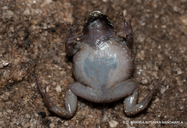|
Description
Uperodon rohani is a small sized frog with snout vent length of 26.0 – 34.0 mm in males and 28.0 – 35.0 mm in females. Head small (HW 6.7, HL 6.2, IFE 3.5, IBE 5.5), less than one-fourth (23.4%) of body length, wider than long (HW/HL ratio 1.1); snout subovoid in dorsal, subovoid to nearly truncate in ventral view, rounded in lateral view, its length (SL 2.6) slightly longer than horizontal diameter of eye (EL 2.5); loreal region rounded with vertical canthus rostralis; interorbital space wider (IUE 2.9) than upper eyelid (UEW 1.6) and internarial distance (IN 1.9); nostril closer to tip of snout (NS 0.7) than to eye (EN 1.4); supratympanic fold distinct, extending from posterior corner of upper eyelid near to insertion of forelimb at axilla; eye diameter (EL 2.5); vomerine odontophores present on the palate, without teeth; presence of two weakly-developed neopalatinal ridges on posterior side of each choana, fused with the vomerine odontophores; tongue emarginate. Forelimbs moderately long and thin; forearm (FAL 5.2) shorter than hand length (HAL 7.2); finger length formula ISkin of dorsum, snout, and between eyes, shagreened; sides of head, posterior part of back, and upper and lower parts of flank, smooth; dorsal surfaces of forelimb, thigh, tibia and tarsus, smooth to shagreened; ventral surfaces smooth. (Garg et al., 2018).
Colour in life: Dorsum reddish brown with pair of irregular olive yellow coloured longitudinal streaks extending from upper eyelids up to vent, scattered olive yellow coloured spots and blotches especially towards dorsolateral surfaces and posterior part of back, larger olive yellow blotch in center of dorsum, few scattered spots on head, olive yellow patch between nostrils and upper eyelids; lateral sides of head brown with scattered olive yellow spots near margins of mouth; anterior and posterior parts of groin light brown; dorsal surfaces of limbs brown to light brown with scattered olive yellow spots; throat light brown with bluish-black calling patch and irregular light grey speckles; chest, belly and thighs, greyish-white with light brown margins; limbs light brown with irregular light grey speckles (Garg et al., 2018).
Colour in alcohol: Dorsum dark brown with irregular olive grey coloured blotches, pair of faint and irregular olive grey longitudinal streaks extending from upper eyelids up to vent; dorsal surfaces of forelimbs and hind limbs lighter in colour compared to dorsum and with faint yellowish-grey spots or blotches; sides of head brown; ventral surfaces (including limbs) greyish-white, throat with blackish-brown calling patch (Garg et al., 2018).
Distribution and Habitat
Country distribution from AmphibiaWeb's database: Sri Lanka
This frog is widely distributed in the lowland wet zone and dry zone of Sri Lanka (Garg et al., 2018; Wijayathilaka et al.,2018; Batuwita et al., 2019).Relation to Humans
Found closest to human-dominated landscapes such as water bodies, agricultural fields, wall crevices, and often from damp areas of houses such as bathrooms and water closets (Garg et al., 2018; Wijayathilaka et al.,2018). Possible reasons for amphibian decline General habitat alteration and loss
Habitat modification from deforestation, or logging related activities
Intensified agriculture or grazing
Habitat fragmentation
Comments
The species authority is: Garg S., Senevirathne G., Wijayathilaka N., Phuge S., Deuti K., Manamendra-arachchi K., Meegaskumbura M. and Biju S.D. (2018).
Uperodon rohani is named after Rohan Pethiyagoda, in recognition of his contribution to biodiversity studies in India and Sri Lanka, especially on frogs and fishes (Garg et al., 2018).
It was historically considered to be conspecific with the Indian species U. variegatus. However genetic analysis showed an average uncorrected genetic distance of 2.8% between the two confirming them as two species (Garg et al., 2018; Wijayathilaka et al.,2018).
References
Batuwita S, Udugampala S, DeSilva M, Diao J and Edirisinghe U. (2019). "A review of amphibian fauna of Sri Lanka: distribution, recent taxonomic changes and conservation." Journal of Animal Diversity, 1(2), 44-82. [link]
Garg S., Senevirathne G., Wijayathilaka N., Phuge S., Deuti K., Manamendra-arachchi K., Meegaskumbura M. and Biju S.D. (2018). "An integrative taxonomic review of the South Asian microhylidgenus Uperodon." Zootaxa, 4384(1), 1-88. [link]
Wijayathilaka N, Senevirathne G., Bandara C., Rajapakse S., Pethiyagoda R., Meegaskumbura M. (2018). "Integrating bioacoustics, DNA barcoding and niche modeling for frog conservation -- the threatened balloon frogs of Sri Lanka." Global Ecology and Conservation, 16, 2351-9894. [link]
Originally submitted by: Dayupathi Eranda Nipunika Mandawala (2021-03-03)
Edited by: Michelle S. Koo (2021-03-03)Species Account Citation: AmphibiaWeb 2021 Uperodon rohani: Rohan's Globular Frog <https://amphibiaweb.org/species/8780> University of California, Berkeley, CA, USA. Accessed Jan 28, 2025.
Feedback or comments about this page.
Citation: AmphibiaWeb. 2025. <https://amphibiaweb.org> University of California, Berkeley, CA, USA. Accessed 28 Jan 2025.
AmphibiaWeb's policy on data use.
|




 Map of Life
Map of Life